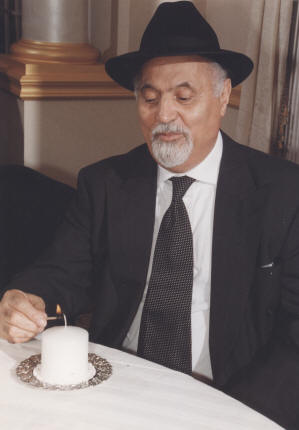
From Sanandaj to Israel and New York, Yedidia Azar Ahyan’s journey is filled with scholarship and dedication. From headmaster to rabbinical authority, he assisted the Jewish community wherever he was, establishing New York’s first Beit Din for Sephardic Jews. His life’s work shaped Jewish education and culture across continents over several generations.
Birth and Family
Yedidia Azar Ahyan was born in 1931 in Sanandaj, into a devout and religious family. His father, Rabbi Yaghotiel, was a revered scholar and held the position of religious leader for the Jewish community in Kurdistan for many years, earning great respect within the community.
Education
Yedidia began his formal education at the Alliance School and later attended Shahpur High School in Sanandaj. Under his father’s guidance, he immersed himself in the study of Jewish law, including the Torah, Mishnah, Gemara, and other foundational religious texts. In 1950, he relocated to Tehran to pursue further education. After passing the university entrance exam, Yedidia completed a master’s degree in Persian literature and child psychology by 1956. In his free time, he continued his religious studies at the same time under Rabbi Halavi at Yeshiva Ozer HaTorah, delving deeper into religious jurisprudence.
Work Life
Career in education
Upon completing his education, Yedidia was employed by the Ministry of Education and later returned to his hometown to serve as the headmaster of the Alliance Schools. For eleven years, he devoted his efforts to teaching religious studies and Hebrew in the economically disadvantaged regions of Kurdistan and Markazi Province. In 1969, Yedidia relocated to Tehran and worked as the principal of the Ettefagh School.
Cultural and social contributions
Yedidia’s influence extended beyond education to cultural and social efforts. He was instrumental in establishing the Khaloutz Hedayati Cultural Center and later took responsibility for overseeing Aliyah (Jewish immigration to Israel) in the Markazi Province. As a result of his influential efforts, he became a member of the Tehran Jewish Committee in the 1980s. Soon, to organize synagogue issues, he founded the High Council of Synagogues in Tehran. In 1981, Yedidia was appointed head of the Beit Din (religious court) of the Tehran Jewish Committee.
Marriage and Migration
Israel
In 1959, Yedidia married Yaffa Aziz, and together they raised two daughters and a son. In 1984, he traveled to Jerusalem to further his religious education in the field of jurisprudence. After two programs, each taking two years, he received Rabbinical ordination from Ramat Gan Hesder Yeshiva, with the endorsement of the Chief Rabbi of Jerusalem, Rishon LeZion Rabbi Eliyahu Mordechai. Following his ordination, Yedidia served for three years as the senior manager of Kashrut (Jewish dietary laws) in Jerusalem, deepening his involvement in religious affairs.
New York
In 1986, Yedidia and his family migrated to New York, where he was appointed rabbi of the Sephardic Synagogue of the Manhattan Society the following year. He also became a member of the Rabbinical Council of America (RCA), a highly esteemed body of nineteen rabbis.
Founding the New York Beit Din for Sephardic Jews
In 1997, Rabbi Yedidia raised the idea of establishing a Sephardic Beit Din (religious court) in New York. The suggestion was welcomed and officially approved and announced by Harav Mordechai Eliyahu, the Rishon LeZion and Chief Rabbi of Jerusalem. With the collaboration of Harav Eliyahu Ben Haim, the Sephardic Beit Din (religious court) of New York was established. During its early years, he personally served as the Secretary-General of this Beit Din for a period, overseeing its initial operations and contributing to its foundation.
Throughout his career, Yedidia actively participated in numerous religious organizations, including Z.A.J.F., R.C.A., and the Sephardic Federation of America, taking on dangerous responsibilities.
Writings and Public Speaking
Despite his extensive responsibilities, Yedidia remained deeply engaged in cultural and religious matters, regularly publishing articles in Persian magazines in the United States. His teachings on Jewish mysticism were broadcast worldwide through Persian media outlets, sharing his insights with a global audience. His other activities include participating in religious seminars and delivering lectures at synagogues and Jewish organizations. Additionally, he has authored several significant works addressing religious and social issues, including:
- Prayers of the Jewish People – a comprehensive translation of the Siddur and daily prayers.
- Interpretation and Translation of Tehillim – a translation of the Psalms of David.
- Jewish Religious Laws – a translation of the Shulchan Aruch, detailing Jewish religious laws and regulations.
- Mitzvot of Rambam – an exploration of the commandments and prohibitions according to Rabbi Moshe Maimonides.
- Five Megillot – translations and interpretations of the Song of Solomon, the Story of Ruth, the Lamentations of Jeremiah, the Book of Ecclesiastes, and the Story of Esther.
- Message of Life – a contemporary interpretation of Torah parshah, addressing modern societal challenges.


 فارسی
فارسی